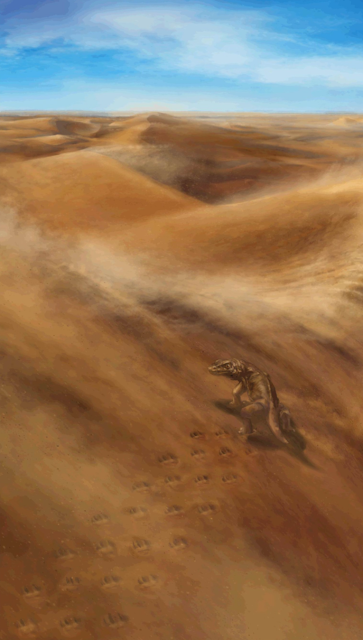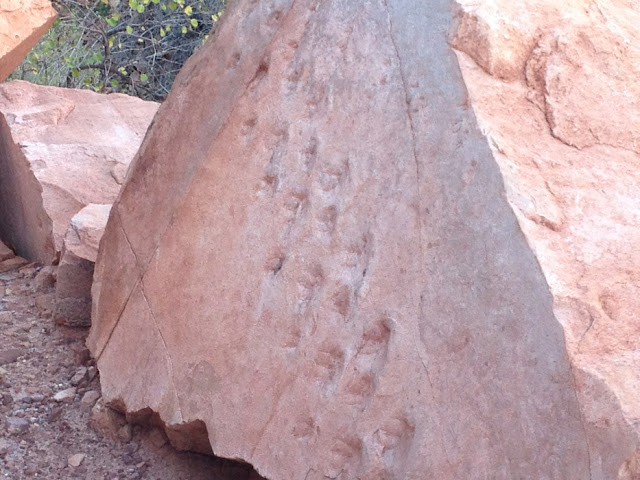Artists rendition of how the new trackway was created from Figure 8 in the paper. Art by Emily Waldman.
SECOND ADDENDUM
AUGUST 20, 2020: Today I received from Professor Steve Rowland at UNLV notice of his publication on this amazing trackway along the Bright Angel Trail in Grand Canyon. When I first came upon this newly fallen boulder in December, 2016, I knew it was something special just by looking at the detail encased on its surface. However, the authors have studied the entire trackway and setting in detail and conclude that: 1) these are the oldest tetrapod trackways in the Grand Canyon; 2) two sets of tracks are present on the dislodged block and are separated in time by only hours or days; 3) a light dusting of new sand (windblown) separates the two sets; and 4) the animals walked up a dune slope that was at an angle of 20° and that the animals walked at a speed of about one foot per three seconds. The trackways resemble those of the ichnofauna (trace fossil) Chelichnus, a common form found in younger layers above such as the Coconino Sandstone.
This paper is Open Access and can be downloaded here.
Citation: Rowland SM, Caputo MV, Jensen ZA (2020) Early adaptation to eolian sand dunes by basal amniotes is documented in two Pennsylvanian Grand Canyon trackways. PLoS ONE 15(8): e0237636. https://doi.org/10.1371/ journal.pone.0237636
Editor: David M. Lovelace, University of Wisconsin Madison, UNITED STATES
Received: October 21, 2019 Accepted: July 30, 2020 Published: August 19, 2020
Copyright: © 2020 Rowland et al. This is an open access article distributed under the terms of the Creative Commons Attribution License, which permits unrestricted use, distribution, and reproduction in any medium, provided the original author and source are credited.
-----------------------------------------------
ADDENDUM
-----------------------------------------------
ORIGINAL POST
December 11, 2016:
Last month Helen and I got to visit Indian Garden located 4.5 miles down the Bright Angel Trail in Grand Canyon. Down in the Pennsylvanian Supai Formation, about 2.5 miles in, we came across a new exposure of a great reptile trackway. I took a few pictures and share them here.
Last month Helen and I got to visit Indian Garden located 4.5 miles down the Bright Angel Trail in Grand Canyon. Down in the Pennsylvanian Supai Formation, about 2.5 miles in, we came across a new exposure of a great reptile trackway. I took a few pictures and share them here.
Blasting was needed to move the rocks off the trail and it is unknown to me if the new trackway was exposed when the rocks fell off the nearby cliff or from subsequent blasting. What is known is that the trail crew was aware of the trackway and placed this boulder in perfect alignment to admire it.
Being closer to the trackway shows some well preserved claw marks in the individual prints (bottom). This must have been a lumbering type of reptile with each track closely spaced but the individual prints about 3 to 4 inches wide.
More claw marks. Two ichnofauna's are described from the Supai - Limnopus and Batrachichnus. A web search did not specify which these might belong to. Another likely candidate for these is Eryops and fossil skeletons that are Pennsylvanian in age have been found in nearby New Mexico. A description of this animal can be found here.
An example of Eryops reconstructed from fossil bones.
A fossil specimen of Eryops on display at the National Museum (Smithsonian, Washington D.C.)
It is possible that this is a set of two individuals walking one after the other. Most descriptions of reptiles from this time period suggest that the back and front tracks are nearly on top of each other and there are four lines of tracks here.
The block is big enough that it should remain in place for a long time.
Thanks to the Grand Canyon trail crew for making this specimen so readily observable.












Interesting read, a bit concerning that the park's geological resources staff find out about these types of things through social media.
ReplyDeleteTurns out that social media "Trumps" the MSM.
ReplyDeleteThanks for the info, Wayne! It'll be impossible to miss seeing it, but can you estimate about where in the Supai this is? And speaking of reptile trackways, do you know if there are any visible in the Coconino along the BA Trail? I know the ones along Hermit Tr, but not any along the BA.
ReplyDeleteThanks for the photos, Wayne, and ditto your thanks to the Park trail maintainers for making the tracks so accessible.
ReplyDeleteHi Wayne! Is this a chunk of Coconino that tumbled down from above, with subsequent surface staining from the surrounding iron oxides?
ReplyDeleteUnknown - This block fell from a cliff of Supai Group just about 6 to 8 feet from the trail. You can see plainly where it fell from. WR
ReplyDeleteThanks for the response. I looked into it a bit further from various articles I came across and found the same thing. Thanks for the help. I knew you'd be the "go-to" guy for that kind of question :) -Nate
ReplyDelete"...the trail crew was aware of the trackway and placed this boulder in perfect alignment to admire it."
ReplyDeleteI was a trail crew laborer in the 1970s, and it was common practice to make these types of "finds" easily available. Many times we would take our lunch breaks in the locale of such "planted" fossils to observe the response of passing hikers. More often than not - due to the rigorous nature of the Grand Canyon hiking experience - most remain oblivious to their surroundings...and for the most part - such treasures go unnoticed by the vast majority of passers-by unless the NPS posts nearby informational signage.
Way back in '82, on my first hike down the Bright Angel, trying to make the river by sunrise, I thought I saw an Eryops in Indian Gardens. Turns out, the terrifying sight was just a backcountry ranger emerging from his tent.
ReplyDeleteMy Aunt Mike Goulding had the trading post in Monument Valley, When I was a kid (I'm 75 now) We went up on a mesa I'm guessing SW of the post to see a hugh trackway. It is red sand stone, flat and probable 100 yards long. Like I said, it's been at least 60 years. I'll check with my family at see if there is more accurate data. Keep up the good work.
ReplyDeleteI saw it in early Sept 2016! Had no idea it was a recent discovery.
ReplyDeleteWOW!! I can't wait to hike down the BA again and find this!! Thanks for sharing wayne.
ReplyDelete